Not everyone dreams of a lush and sprawling backyard. So playing down diminutive outdoor space in your listing could be a missed opportunity to connect with a buyer who sees a postage-stamp lawn or a compact front stoop as a plus, says Meridith Baer, owner of Meridith Baer Home, a staging firm based in the Los Angeles area. “Actually, it’s sometimes easier to make a small space charming. It might be as simple as adding shutters in a pretty hue and painting the front door, or putting that perfect set of chairs on the front porch,” she says. Whether you’re dealing with a small backyard in a single--family home or simply a balcony or patio for a townhouse or condo, these tips can help homeowners or stagers make a bigger statement.
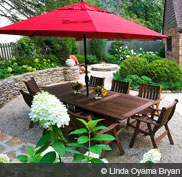
Decluttering is just as crucial for outdoor spaces as it is the rest of the house. “It’s important not to do too much and overcrowd a small space,” says Dennis Hammett, sales associate with Ebby Halliday, REALTORS®, in Dallas. Too many chairs around a table or even too large a tree can make a smaller yard feel confined. “Placement and size of plants becomes very important with a small front yard. You want to make sure that none are so big that they will block any of the home’s architectural features,” says Jason Evans, marketing manager for The Davey Tree Expert Co. in East Bay, Calif. Keep garden statues and ornaments to a minimum, Evans adds.

Smaller spaces often benefit from an attention-grabbing feature, such as a water fountain, outdoor fireplace, or a restful nook in a compact garden. “If you have a small space, pick a focus to start with,” says Justin Hancock, garden expert with Costa Farms in Miami. “You might want to rent or borrow a small patio set or fire pit to get buyers thinking about how great the backyard will be for entertaining or outdoor living.” You can also draw attention verbally to a focal point. For example, call out the benefits to the home’s outdoor plantings—if they, for example, attract butterflies or hummingbirds, Hancock says. “A quick handout that highlights the upsides to areas of the yard can be helpful to consumers who may not realize those benefits on their own.”
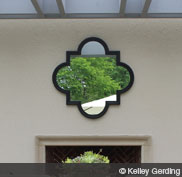
“Try a trick borrowed from interior designers: Hang an outdoor-friendly mirror on an exterior wall to reflect light and to make these yards feel more open,” says Missy Henriksen, spokeswoman for the National Association of Landscape Professionals. While there’s no wrong or right style of outdoor mirror, Henriksen offers some suggestions: Hang the mirror no lower than eye level, ensure it’s rustproof, and try a mirror that mimics shapes and styles of real windows. Pay attention to what you’re reflecting, too. “You want to show off the gorgeous greenery of your landscape, not a bare wall or barbecue,” Henriksen says.
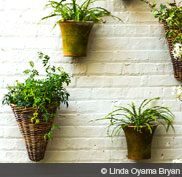
Taller plants can add height to a doorway that feels closed off, Henriksen says. A spiral topiary in a container beside a front door can nicely accentuate a space. Another tip: Prune plants so they’re more vertical, training them to grow up rather than out. Also, consider a vertical wall of planters, like containers of ornamental grasses. You can also raise plant height by several feet using retaining walls, raised beds, or extra long, slender containers.
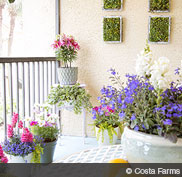
Container gardens are portable, which make them an easy way to enhance a small space, particularly for a townhouse or condo where a homeowners association or shared space may limit what you can install. Matching containers placed on each side of a stairway or doorway can create a bookend look, suggests Hancock. Or, group a small cluster of different sizes of containers. Choose plants that complement or contrast with the color of your front door. For example, with a red door, choose red geraniums, salvia, or petunias, Hancock suggests. For a high-contrast look with a blue door, try planting easy-care golds and yellows, such as zinnias, marigolds, or celosia. “If floor space is at a premium, try a hanging basket or two,” says Hancock.

Turn a spotlight on what you do have, from above and below. “Outdoor lighting is an easy way to showcase the entry and complement your landscaping,” says Hammett. Solar lights can be added affordably and without extra wiring. Point lights up at trees, and place them along the driveway and planting beds to create a landscape with a soothing glow, Hammett says. Also, consider wall-mounted task lighting, such as sconces, to spotlight outdoor cooking areas. “Gas lanterns can add a touch of elegance, “ Hammett says.
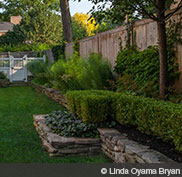
Use the colors of nature to add lushness and texture to the space. You’ll be in good company with designers on this one, as the Pantone Color Institute’s color of the year is a verdant shade called “greenery.” NALP is also highlighting simpler greenery for 2017. A formal hedge of green velvet boxwood, a border of green lilyturf, or dense Boston ivy-colored trellises can have just as much impact as a garden full of colorful flowers, NALP notes. “Everyone loves a pop of color, but don’t shy away from the striking simplicity of outdoor neutrals, especially in smaller yards,” Henriksen says. Try ornamental grasses and trees potted in a container. In drought-prone areas, consider a small patch of low-water options like Kurapia, a ground cover with white flowers that can work in various soils and requires little watering to maintain.
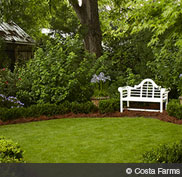
Small yards often lack privacy, and neighbors are usually in close proximity. Taller plants, vines, bamboo, or an arbor with a large flowering vine can help create a more intimate space. A trellis on a balcony of a condo can also help. “Privacy doesn’t have to be expensive—even a lattice panel or two can do the job,” Hancock says. A hedge is the easiest and most affordable way to add privacy in a yard, Baer says. “If you want to save money, get a younger specimen and have the broker point out that in a year’s time you won’t see the neighbors,” Baer says.
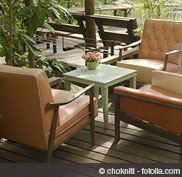
Connect the indoor space to the outdoor space to make the living space feel larger. Use the same colors you find inside the home in the exterior color scheme, starting with cushioned furnishings and outdoor throw pillows for an easy match. Add a waterproof rug to ground the space as an outdoor room. Consider a pergola or gazebo to extend the interior feel. “Outdoor structures can help define your space and do not have the confinement of four closed walls, so they are typically good choices for smaller properties,” Henriksen says.




